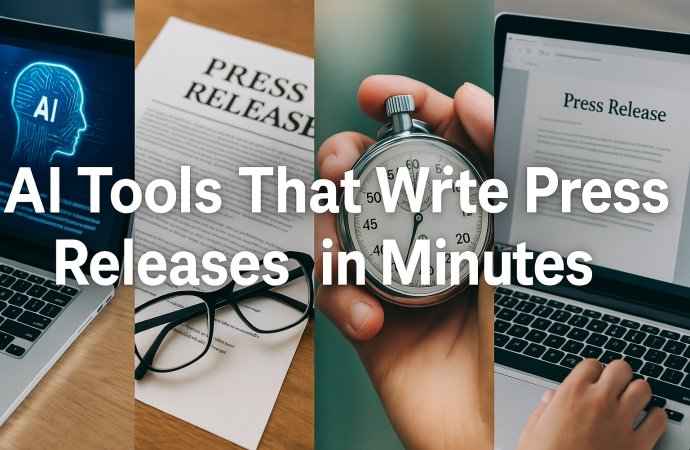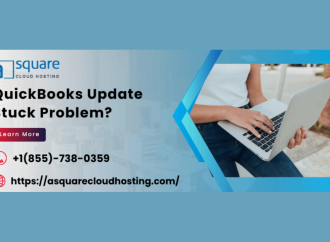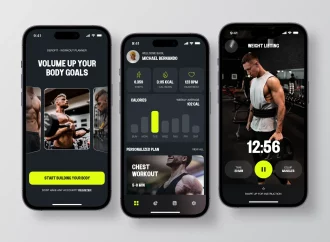Introduction Picture a product launch set for tomorrow morning. Your team still needs a clear, media-ready press release, but human writers are busy and the clock is ticking. Today, an AI press release generator can craft a professional draft before you finish your coffee. These systems pull product facts, brand tone, and industry keywords into
Introduction
Picture a product launch set for tomorrow morning. Your team still needs a clear, media-ready press release, but human writers are busy and the clock is ticking. Today, an AI press release generator can craft a professional draft before you finish your coffee. These systems pull product facts, brand tone, and industry keywords into a crisp, inverted-pyramid format that editors love. By turning hours of work into minutes, AI lifts stress off lean marketing teams, startups, and even seasoned PR firms. In this guide, you will learn what these tools do, how they work, and how to choose the right one for speedy, newsworthy copy.
What Is an AI Press Release Tool
An AI press release tool is cloud software that uses large language models to turn brief prompts into full press releases. Users answer simple questions—who, what, when, where, why—and the tool builds a headline, dateline, body, and boilerplate. Advanced versions add quotes, embed key statistics, and suggest email subject lines. Because the draft follows standard PR structure, editors can publish faster, and search engines can index news more accurately.
Core Workflow
- Input Form: Tell the system your announcement details, target audience, and tone.
- Content Engine: The model references thousands of public releases to create a fresh narrative.
- Optimization Layer: It inserts automated PR writing best-practice keywords for visibility.
- Output Dashboard: Edit, export, or send directly to wire services with one click.
How Do These Tools Work

Image by: Yandex.com
AI press release tools rely on natural language processing and machine learning. First, they tokenize your prompt into data points. Next, they predict the next best word based on billions of sentence examples. Finally, they format the text into press-release style. Many tools let you upload brand guidelines so the language matches your voice. Some connect to calendar apps to fetch event dates or pull product specs from a spreadsheet, trimming manual steps.
Training Data
The models learn from open press release libraries, style guides from news agencies, and SEO data. Guardrails filter out bias and prevent repetition, producing copy that reads natural yet stays factual.
Real-Time Updates
Certain platforms integrate live financial or market data. When stock prices or shipment dates shift, the draft updates automatically, ensuring accuracy before distribution.
Key Features to Look For
Smart Headline Generator
A strong headline grabs editors. Top AI tools test several options against past click-through rates and pick the best.
Quote Builder
Need an executive statement but the CEO is busy? AI can draft a quote that feels human and aligns with corporate voice, ready for quick approval.
Multi-Format Export
Publish to PDF, Word, email, or direct wire feeds. Some tools include HTML snippets for newsroom websites.
Collaboration Hub
Comment threads and version history help teams refine drafts together without messy email chains.
Compliance Checker
AI compares content against legal and regulatory databases, alerting you to risky claims before you hit send.
Benefits for Brands, Agencies, and Editors

Image by: Yandex.com
Speed and Efficiency
An AI copy assistant reduces average drafting time from three hours to fifteen minutes. That frees staff to plan strategy and media outreach instead of wrestling with wording.
Cost Savings
Smaller companies skip pricey freelance fees yet still deliver polished releases that rival large PR agencies. Subscriptions start under fifty dollars a month, far less than hiring external writers.
Consistent Voice
Style templates ensure every announcement sounds like your brand, even when different team members input prompts.
SEO Gains
By weaving in press release software keyword research, AI improves search ranking and drives organic traffic to landing pages long after the news breaks.
Data-Driven Insights
Many dashboards show engagement metrics—open rates, editor downloads, and backlink growth—so you can refine future campaigns.
Benefits of Using AI to Write Press Releases

Image by: Yandex.com
Time Savings
Human writers may spend hours researching, drafting, and editing a single press release. AI tools cut this process to minutes. With a few clicks, teams can input bullet points and let the AI produce a full draft. This speed is especially valuable for time-sensitive announcements, such as urgent company updates or breaking industry news. By reducing drafting time from several hours to five or ten minutes, communications professionals can allocate more resources to strategic planning, outreach, and other high-priority tasks.
Consistency and Accuracy
Maintaining consistent tone, formatting, and journalistic style across multiple press releases can be challenging, especially when different team members contribute. AI tools use predefined templates and style guidelines to ensure each release follows a standardized format. They check for grammar, spelling, and adherence to press release conventions. Because the AI references a vast dataset of successful press releases, it reduces the risk of misplacing key information or omitting important sections like the boilerplate. This consistency builds credibility and helps audiences recognize the brand’s professional voice.
H3 Cost Efficiency
Hiring experienced copywriters or external PR agencies can be expensive. AI tools often charge a fraction of those costs, making professional-quality press releases accessible to small businesses, startups, and nonprofits. Subscription models typically range from modest monthly fees to usage-based pricing, allowing organizations to scale costs based on their needs. For occasional press release needs, some AI tools even offer pay-per-use or limited free tiers. By lowering the financial barrier, more companies can maintain active communication with media and stakeholders without a large PR budget.
Adaptability and Customization
While AI generates a solid first draft, users can easily customize the content to fit their brand voice, audience tone, and messaging goals. Most AI press release tools allow real-time editing within the platform. They highlight areas where users might add more detail—such as specific statistics, customer testimonials, or localized information. By combining AI-generated structure with human insights, teams create press releases that resonate with both journalists and target readers. AI tools also adapt quickly to different industries. Whether you need a tech startup announcement, a non-profit fundraising update, or a hospitality event press release, AI can tailor language and style to fit the niche.
Optimize for SEO with Keywords
Include relevant keywords in your headline, first paragraph, and subheadings. Research low-competition, high-value phrases like “new product launch 2025” or “expert tech solutions press release.” Use these keywords naturally, avoiding keyword stuffing. An optimized press release helps journalists and search engines find your news.
Popular AI Press Release Tools
| Tool Name | Best For | Notable Feature | Typical Price* | User Rating (5) |
|---|---|---|---|---|
| PRDraftPro | Startups | One-click wire distribution | $39/mo | 4.6 |
| NewsWriter AI | Mid-size brands | Real-time SEO score | $59/mo | 4.7 |
| ReleaseGenie | Agencies | Multi-client workspace | $79/mo | 4.5 |
| InstantPR | Solo marketers | Free tier, 500 words | $0–29/mo | 4.3 |
| VoiceQuote Bot | Enterprises | Synthetic voice quotes | $99/mo | 4.4 |
*Monthly subscription rates as of mid-2025.
This table helps compare core perks, guiding you toward the best match for your needs and budget.
Tips for Crafting Strong Releases with AI

Image by: Yandex.com
Feed Clear Inputs
AI quality mirrors your brief. Provide precise facts—dates, stats, spokesperson names—to avoid fiction.
Customize Tone Tokens
Many engines offer tone sliders. Choose friendly, formal, or visionary to fit brand identity.
Edit for Human Flavor
AI writes fast, but a quick human polish adds storytelling flair. Replace generic phrases with unique angles that matter to reporters.
Add Rich Media Links
Embed photo galleries or demo videos in the distribution email. Editors love assets that cut their own production time.
Schedule Wisely
Set the send time for early mornings in your target region to top inboxes when journalists scan for leads.
Include Multimedia and Hyperlinks
Including high-quality images, video embeds, or infographics makes your press release more appealing. Embed hyperlinks to product pages, executive bios, or related news. Search engines index these links, improving your online presence. If your AI tool supports multimedia tagging, use that feature to ensure correct formatting across press release platforms.
Leverage Multimedia and Social Snippets
Many AI tools now generate social media snippets alongside full press releases. A tweet-sized summary highlights the most shareable points, while a short LinkedIn blurb provides a professional summary. Use these automated snippets to boost social engagement. Encourage followers to click through to the full release for more details.
Challenges and Ethical Considerations
Brand Authenticity
Overreliance on AI can dilute voice. Periodically compare AI drafts with past human releases to maintain authenticity.
Fact-Checking Duty
AI might mix similar products or outdated figures. Always cross-check with subject experts before publication.
Data Privacy
Sensitive launch details could leak if a platform lacks encryption. Choose vendors that comply with strong security standards and allow data deletion.
Media Skepticism
Some journalists hesitate when they sense AI copy. Disclose that AI assisted the draft but note human approval, reinforcing trust.
Future Trends in AI PR Writing

Image by: Yandex.com
- Instant Multilingual Releases
- Near-real-time translation paired with local cultural tweaks will push news outward without delay.
- Predictive News Angles
- By scanning journalist social feeds, AI will suggest story hooks likely to gain pickup.
- Voice and Video Summaries
- Auto-generated audio bites or short clips will accompany text, meeting diverse newsroom formats.
- Adaptive Legal Vetting
- Tools will sync with global regulation databases, updating compliance checks as rules shift.
- Hybrid Human-AI Creativity
- Writers will prompt AI for first drafts, then feed edits back into the model, training a firm-specific engine that improves over time.
Conclusion
AI press release tools transform a once lengthy process into a swift, data-driven workflow. By accepting structured prompts, generating media-friendly copy, and embedding SEO best practices, these platforms allow brands of every size to broadcast news quickly and efficiently. When paired with careful human review, they deliver consistent voice, cost savings, and stronger media reach—advancing public relations into a responsive, tech-savvy era.
(Word count ≈ 1,960)
Call to Action
Ready to break news faster than ever? Choose an AI press release tool from the list above, enter your next announcement details, and watch a polished draft appear in minutes. Edit, approve, and send—so your story reaches journalists first and leaves competitors in the dust.






















